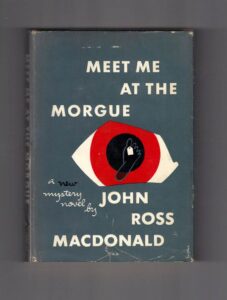A SERIOUSLY UNDERAPPRECIATED BOOK

Where’s Lew?
“Negative space, in art, is the empty space around and between the subject(s) of an image.[1] Negative space may be most evident when the space around a subject, not the subject itself, forms an interesting or artistically relevant shape, and such space occasionally is used to artistic effect as the “real” subject of an image” (Wikipedia)
After four Archer books, Macdonald introduces a non-series detective, Howard Cross, a probation officer. Aside from Wolfe’s lengthy plot summary, the critical focus is on what it means to what is essentially the Lew Archer series that Macdonald is taking a vacation from his creation. Very little is said about the merits of the book itself.
I am going to depart from the format of my usual opening post when I start a new book. Peter Wolfe, in Dreamers Who Live Their Dreams, discusses the literary structure of the book at some length; Kreyling and Schopen each make their own contributions, but everyone’s focus is on the absence of Lew Archer.
Your Relationship Status With Your Detective: “It’s Complicated”
The first decision for series writers, when they contemplate the next book, is whether to continue the series or try a stand-alone. There are plenty of reasons to keep the series going:
- If you have a third-party publisher, your editor will tell you that the series is the safer bet. The next book is practically pre-sold to anyone following the series already.
- If the book is successful it will motivate readers to seek out the earlier books.
- The core work of creating your detective and his surroundings has already been done.
- You can create growth in your characters compared to earlier books.
- The environment you can create over multiple books will be more complex than you can do in a single volume.
- References to past events and the use of recurring secondary characters will provide a richer reading experience for your readers who have read the earlier books.
And there are reasons to step away, at least for a while:
- The more backstory you give your detective and your other characters, the more you limit your options. What happened to that nice girl he was dating at the end of the last book? Didn’t his new job at the FBI work out? Why not? You said he was moving to Omaha and he’s still in Chicago!
- It becomes increasingly more difficult to keep the continuity of the series as the detective’s history becomes more complex.
- If you are writing as a primary means of support, writing a series along with non-series books increases the number of books you can publish each year.
- A non-series book, especially if coupled with a pseudonym, allows you to experiment with point of view and subject matter in ways that would be disruptive in a series book.
It’s Personal to the Writer
- Is your idea for your non-series detective truly fresh, or are you just writing the same detective with a new name?
- Is there potential for the new detective to be a series protagonist?
- Have you reached the end of the dramatic possibilities of your series?
- Is the attraction of a non-series book genuine, or are you just procrastinating?
- Is your series detective helping or hurting the quality of your writing?
A Personal Perspective
“The kind of crazy you get from too much choice.”
— Joni Mitchell
I write in the most restrictive format possible:
- I write a series.
- It is also a serial—the events occur in a strict order.
- Each case takes no more than one month.
- The series takes place in 1990, which is rapidly becoming the remote past.
A famous author—it may have been Chandler but I can’t find the attribution right now—said that the private detective form was strict as a sonnet. He was talking about mysteries generally but his remark applies with even more force to the series detective. Personally, I am happy to work within those limitations. It may be my legal training or my lack of imagination, but I find that it makes the work easier, not harder, because the reader approaches my story with a clear expectation of the conventions of the genre.
For me, the challenge is to work within these limitations and avoid repeating myself. I try hard to approach each book after The January Corpse in a radically different way:
- The February Trouble was my homage to Ross Macdonald.
- Burning March was my book about a life in the law.
- Cruel April was an exercise in sustained suspense.
- Appointment In May was another approach to Macdonald’s themes, from a different direction.
- Tangled June was a fictionalized approach to my search for my own birth parents, as well as an experiment with alternating first person points of view.
- Cold July was about the cost of trying to change fate
- August Hearts was my MacGuffin story.
- The September Wars (not yet released at the time of this post) is about the burden of the past on the present; specifically, my detective’s war experience.
Back to Macdonald and then on to the Book
Without making any spoilers, what does Macdonald do with the artistic freedom he achieves without Lew Archer? Not a lot. His detective, Howard Cross, speaks and acts much like Lew Archer. The plot includes the possibility of a romance, something that will not happen to Lew Archer for another thirty years. With minimal change, this book could easily have been written as part of the series.
But let’s not fall into the trap of just talking about the negative space created by the absence of Lew Archer. The book has some flaws, mostly involving the inclusion of unnecessary material, but at its core it’s a strong mystery with a surprising twist.
Let’s get started.
Recent Comments